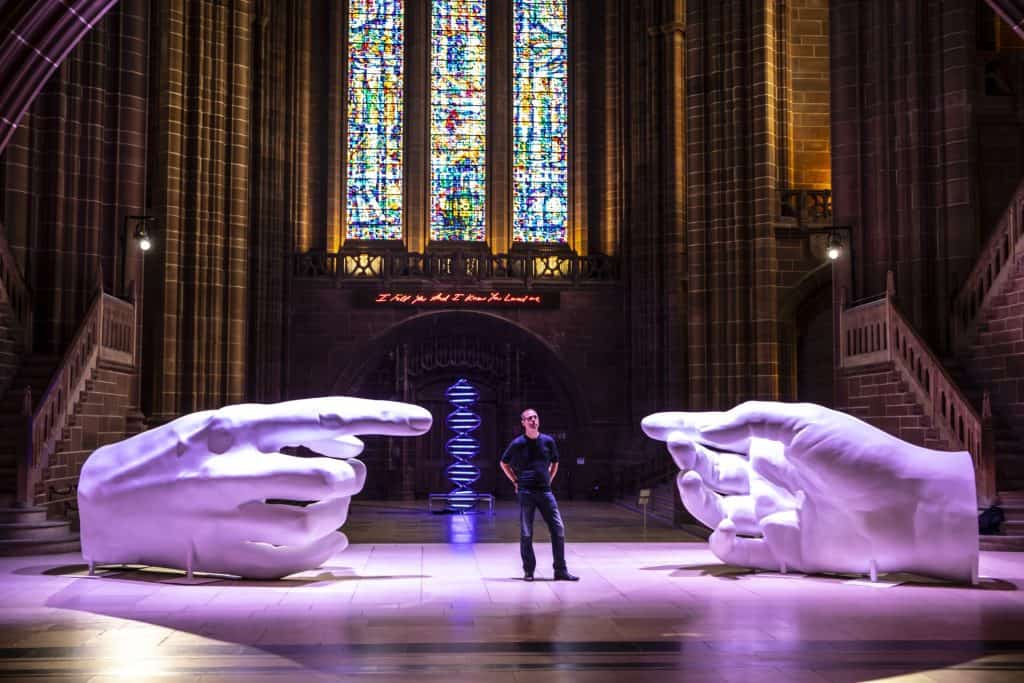By Angela Youngman
Light is a crucial element in every religion and artists are now using it to create images and experiences that inspire people of all ages and faiths.
It is a style of art ideal for cathedrals, vast edifices imbued with centuries of prayer. These are locations that generations of people have used for inspiration, reflection and comfort. And this Advent, many of them are bathed in lights, outside and in.
Many of the Advent light shows are created by Peter Walker of Luxmuralis. “What we are doing is unprecedented,” he says. “This is more than a son et lumière. We use fine art like Renaissance painters to create modern, contemporary ways of talking about the world. It is connecting people, views and ideas.
“Such subjects as science, renaissance, life and space are placed in the context of the greater universe. We explore how these interweave with the history of the sacred space, always creating a match between the subject and the site. We put the building centre stage — crypt, aisles, nave — to take people in a pilgrimage around the building.”
Bristol Cathedral hosted Force of Nature at the beginning of November, which explored the four elements in relationship to religion, mythology and art history. Visitors discovered the flaming power of volcanos, before being immersed in sky and air.
Frances Rosewell, the cathedral’s visitor director, said: “We hoped it would inspire people to feel in touch with the world. The installation entirely transformed the space, and used every available inch of our home to create a show-stopping experience for many.”
None of the sessions is designed to teach or provide a specific interpretation of a concept. Instead, they appeal to emotions, and evoke a spiritual response.
“We have had people sitting on the floor of the nave for 30 to 40 minutes at a time watching. People are mesmerised by the light,” Mr Walker says. “There have been people who come in at 6.30pm and stay until the end, totally absorbed. The feedback comment we often hear is, ‘It moved me, it was spiritual, it connected me with the cathedral’.

“Even though we live in a secular world, people are spiritual beings. Some people may not have been in a cathedral before. It is inclusive. Over the past 10 years this type of light art has opened cathedrals to people who don’t know about them, or have just started a journey, or haven’t been able to express feelings.
“It can open people to faith. It may be the one time that they encounter the building, giving them a reason to come through the door and can encourage them to come back.”
Sustainability and cost-effectiveness are crucial to every event, which can last from a few days to a few weeks.
Luxmuralis is a team of two: Mr Walker and musician David Harper. When on site, they are backed by a small group of technical and production specialists. Additional costs and the carbon footprint involved are minimal because Luxmuralis owns most of the equipment. Energy costs are far lower than the power used to illuminate the exterior of a building at night.
“We repurpose and rework themes wherever possible to maximise the number of people who can see it,” Mr Walker adds. “It is important to bear in mind that it is a sacred site, and these installations have to resonate with the building, the life of the people in it and the links with the wider society around it. This is not art for the sake of art. Light art should not be seen as an art gallery or a festival. It is something different.”
Tickets help to pay for the upkeep of the building, and the numbers of people attracted into the area often provide additional income for local businesses, shops and cafés.
Cathedrals certainly approve, and many rebook light events year after year. St Albans Cathedral has hosted annual events since 2018 covering poppy fields, space, and renaissance. Sarum Lights at Salisbury Cathedral focused on heaven and earth in 2021, renaissance for 2022.
Visitors certainly approve, too. Events sell out. Once inside, people can stay as long as they want. Depending on the size of the building, visitor numbers can be vast, with 3,000 or more each evening.
“There is a risk of oversaturation,” Mr Walker admits. “Light art can be too commercial and oversaturated within the market, as can be seen in terms of the Van Gogh experience, Monet experience etc. These are just ways of making money from well-known artists and can easily become repetitive.
“Light art in a cathedral or church setting is different from that of a commercial art gallery. The type of event that Luxmuralis does is part of movement towards a more spiritual community and this will continue to develop since it is art for a diverse, varied community. This is art that is like nothing else people have seen before.”

















